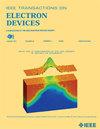双SOI nmosfet中后门偏压对总电离剂量和热载流子注入效应的影响
IF 2.9
2区 工程技术
Q2 ENGINEERING, ELECTRICAL & ELECTRONIC
引用次数: 0
摘要
双绝缘体上硅(DSOI)器件由于后门偏置(${V}_{\text {bg}}$)调制,对总电离剂量(TID)效应具有较高的耐受性。负${V}_{\text {bg}}$用于补偿由TID效应引起的性能下降,正${V}_{\text {bg}}$用于补偿由热载流子注入(HCI)效应引起的性能下降。本文重点研究了不同后门电压和${V}_{\text {bg}}$调制效应下TID和HCI之间的协同效应。由于氧化物中被捕获的电荷增强了通道区电离的影响,从而使HCI效应被TID效应加剧。无应力DSOI MOSFET的${\Delta} {V}_{\text {th}}$ [${V}_{\text {th}}$在3 Mrad(Si)处$- {V}_{\text {th}}$在0 Mrad(Si)处]约为- 0.215 V,比有应力器件大。此外,在协同实验中,对中硅施加反向偏置是抑制降解的有效方法。本文章由计算机程序翻译,如有差异,请以英文原文为准。
Impact of Back-Gate Bias on the Total Ionizing Dose and Hot Carrier Injection Effects in Double SOI nMOSFETs
Double silicon-on-insulator (DSOI) device exhibits high tolerance to total ionizing dose (TID) effect due to back gate bias ( ${V}_{\text {bg}}$ ) modulation. Negative ${V}_{\text {bg}}$ is required to compensate for the performance degradation caused by the TID effect, while positive ${V}_{\text {bg}}$ is required to compensate for the degradation caused by hot carrier injection (HCI) effect. This article focuses on the synergistic effect between TID and HCI under different back-gate voltage and modulation effect of ${V}_{\text {bg}}$ . The HCI effect is exacerbated by TID effect owing to the trapped charges in the oxide, which enhance the impact of ionizing in channel region. ${\Delta } {V}_{\text {th}}$ [ ${V}_{\text {th}}$ at 3 Mrad(Si) $- {V}_{\text {th}}$ at 0 Mrad(Si)] of DSOI MOSFET without stress is approximately −0.215 V, larger than that of stressed device. Additionally, applying a back-gate bias to mid-Si is an effective method to suppress the degradation in synergistic experiments.
求助全文
通过发布文献求助,成功后即可免费获取论文全文。
去求助
来源期刊

IEEE Transactions on Electron Devices
工程技术-工程:电子与电气
CiteScore
5.80
自引率
16.10%
发文量
937
审稿时长
3.8 months
期刊介绍:
IEEE Transactions on Electron Devices publishes original and significant contributions relating to the theory, modeling, design, performance and reliability of electron and ion integrated circuit devices and interconnects, involving insulators, metals, organic materials, micro-plasmas, semiconductors, quantum-effect structures, vacuum devices, and emerging materials with applications in bioelectronics, biomedical electronics, computation, communications, displays, microelectromechanics, imaging, micro-actuators, nanoelectronics, optoelectronics, photovoltaics, power ICs and micro-sensors. Tutorial and review papers on these subjects are also published and occasional special issues appear to present a collection of papers which treat particular areas in more depth and breadth.
 求助内容:
求助内容: 应助结果提醒方式:
应助结果提醒方式:


